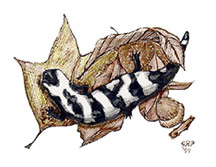 |
|||
|
Volume 12, Issue 36 ~ September 2 - 8, 2004
|
|||
|
|
 The eastern United States possesses a great diversity of salamanders. Biologists believe that these creatures originated in the Appalachian Mountains. Some of the higher peaks have endemic species unique to that particular place. The eastern United States possesses a great diversity of salamanders. Biologists believe that these creatures originated in the Appalachian Mountains. Some of the higher peaks have endemic species unique to that particular place.The marbled salamander is widespread and common, but compared to other common species it is rarely encountered and not much is known about its habits. What is known, however, sets it apart from other amphibians. Most amphibians in Maryland lay their eggs in water during the spring. Marbled salamanders move from the upland woods to lay their eggs in dry vernal pools. Their migration begins in September, on nights when there is at least a little rain. Though dry in autumn, vernal pools fill with water from winter rains and snow, providing habitat for the salamander tadpoles to hatch and grow. The vernal pools then dry out in summer. At Jug Bay Wetlands Sanctuary in Southern Anne Arundel County on the night of September 15, 1999, the night Hurricane Floyd struck, over four inches of rain fell. Volunteers at the sanctuary, working with naturalist Karyn Molines, counted almost 150 marbled salamanders on the move by 9:30pm, for a sanctuary record. In previous seasons, over 400 marbleds had been recorded. These numbers indicate that these salamanders are fairly common, even though during the rest of the year they are rarely seen. Why? Part of the answer is that they are fossorial, meaning that they spend most of their time underground. The woodland top soil is rich with salamanders and other life forms. So walk softly and look carefully. You might be in for a small surprise. |
||
|
© COPYRIGHT 2004 by New Bay Enterprises, Inc. All rights reserved. |

